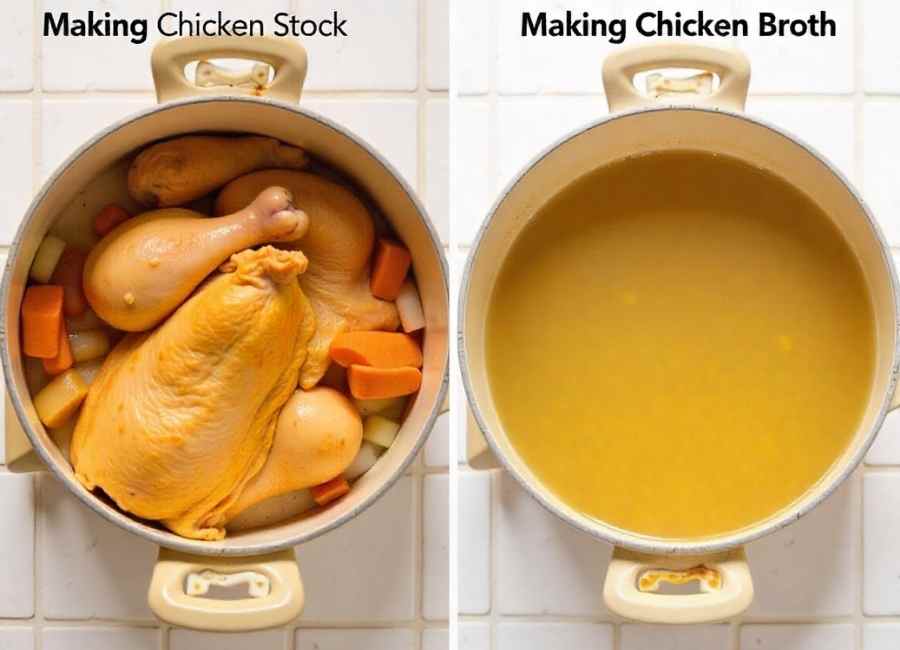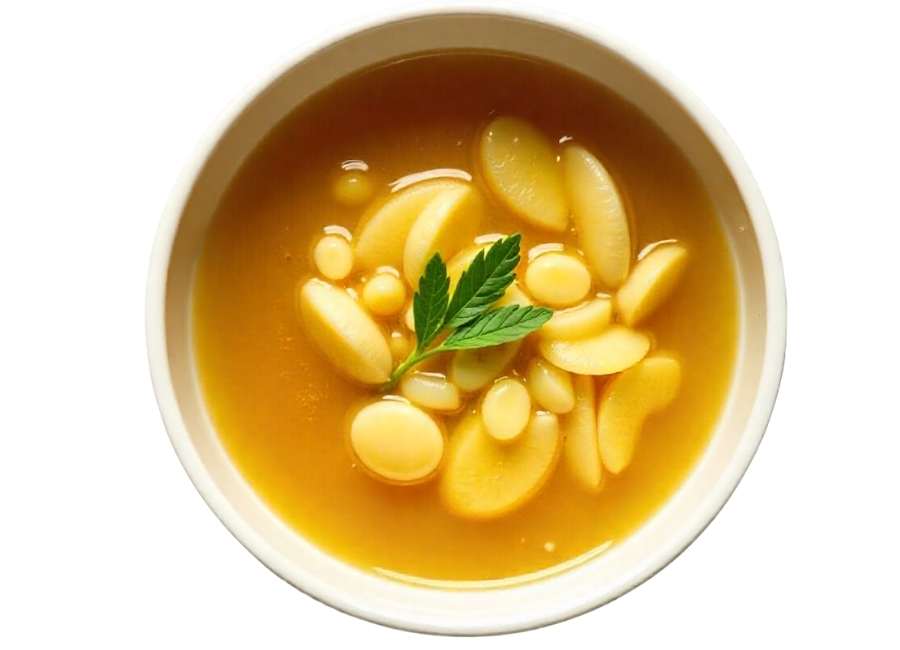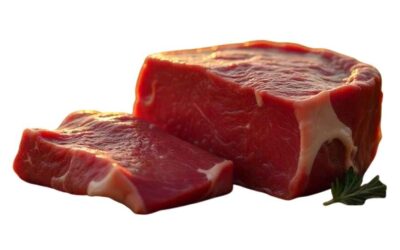Walk down any grocery aisle and you’ll find cartons labeled “chicken stock” sitting right next to ones marked “chicken broth.” Many Home cooks grab whichever is on sale, assuming they’re basically the same thing. While both are flavorful liquids made from chicken, the differences between stock and broth can significantly impact your cooking results.
Understanding these distinctions will help you choose the right base for your soups, sauces, and other dishes. Whether you’re making a delicate consommé or a hearty chicken noodle soup, using the correct liquid foundation can elevate your cooking from good to exceptional.
Let’s break down what sets these kitchen staples apart and when to use each one.
What Is Chicken Stock?

Chicken stock is made primarily from bones—specifically chicken bones that are often roasted first to develop a deeper flavor. The bones are simmered for several hours, typically 4-6 hours or even longer, which allows the collagen in the bones to break down into gelatin.
This lengthy cooking process creates a rich, gelatinous liquid that becomes firm and jelly-like when chilled. The gelatin gives stock its characteristic body and mouthfeel, making it an ideal base for sauces, gravies, and dishes where you want substantial flavor and texture.
Characteristics of Stock:
- Made primarily from bones (with minimal meat)
- Simmered for 4-6+ hours
- Rich in gelatin from collagen breakdown
- Thicker, more viscous texture
- Neutral, deep flavor
- Sets like jelly when refrigerated
What Is Chicken Broth?

Chicken broth, on the other hand, is made from meat and bones together, though meat typically takes the starring role. The cooking time is generally shorter—usually 1-3 hours—which means less collagen extraction and a thinner final product.
Broth tends to have a more pronounced chicken flavor since it includes more meat in the cooking process. It’s often seasoned during cooking, making it ready to drink on its own or use as a lighter base for soups and other dishes.
Characteristics of Broth:
- Made from meat and bones (meat-forward)
- Simmered for 1-3 hours
- Lower gelatin content
- Thinner, more liquid consistency
- More pronounced chicken flavor
- Often pre-seasoned
The Cooking Process: How They’re Made Differently

The preparation methods for stock and broth reflect their different purposes and final characteristics.
Making Chicken Stock
Stock production focuses on extracting maximum collagen and minerals from bones. Many recipes call for roasting the bones first at high heat to develop complex, caramelized flavors through the Maillard reaction. The bones are then covered with cold water and brought to a gentle simmer.
The long, slow cooking process—often 6-12 hours for the most concentrated results—allows collagen to break down fully. Aromatics like onions, carrots, and celery are added for depth, but the bones remain the star of the show.
Making Chicken Broth
Broth preparation emphasizes flavor extraction from meat. Whole chicken pieces, including both meat and bones, are simmered with vegetables and herbs. The shorter cooking time preserves the meat’s flavor while preventing it from becoming completely tasteless.
Since broth is often consumed directly, it’s typically seasoned with salt, pepper, and herbs during the cooking process. This makes it more immediately palatable than unseasoned stock.
When to Use Stock vs. Broth

Choosing between stock and broth depends on your cooking goals and the specific dish you’re preparing.
Best Uses for Chicken Stock
Stock shines in applications where you need body, richness, and a neutral base that won’t compete with other flavors:
- Sauces and gravies: The gelatin content helps create smooth, glossy sauces that coat ingredients beautifully
- Risotto: Stock’s thickness helps create the creamy texture risotto is known for
- Braising liquids: The rich mouthfeel enhances slow-cooked dishes
- Reduction sauces: Stock reduces beautifully without becoming overly salty
- French cooking techniques: Classic French cuisine relies heavily on well-made stocks
Best Uses for Chicken Broth
Broth works best when you want immediate chicken flavor and don’t need the thickness that stock provides:
- Chicken noodle soup: The pronounced chicken flavor is exactly what you want
- Cooking grains: Rice, quinoa, and other grains benefit from broth’s seasoning
- Drinking warm: Broth is comforting to sip on its own
- Quick weeknight meals: Pre-seasoned broth saves time and adds instant flavor
- Lighter soups: When you want flavor without heaviness
Store-Bought Options: What to Look For

Commercial stocks and broths vary widely in quality. Reading labels carefully helps you choose products that will enhance rather than compromise your cooking.
Quality Indicators
Look for products with short ingredient lists featuring recognizable items. The best commercial options contain chicken, vegetables, and minimal additives. Avoid products with excessive sodium, artificial flavors, or long lists of preservatives.
Some premium brands now offer bone broth, which falls somewhere between traditional stock and broth. These products typically have higher protein content and more gelatin than regular broth but aren’t as concentrated as homemade stock.
Storage and Shelf Life
Both stock and broth can be refrigerated for 3-4 days or frozen for several months. Homemade versions generally have shorter shelf lives than commercial products due to lower sodium content and lack of preservatives.
Making Your Own: Tips for Success

Creating homemade stock and broth gives you complete control over flavor, sodium content, and quality. Here are key tips for both:
Stock-Making Tips
- Roast bones at 400°F for 30-45 minutes before simmering for deeper flavor.
- Start with cold water to extract maximum nutrients.
- Maintain a gentle simmer—never a rolling boil.
- Skim foam regularly during the first hour.
- Don’t season until the end (if at all)
Broth-Making Tips
- Use a combination of dark and white meat for balanced flavor.
- Add vegetables in the final hours to prevent overcooking.
- Season gradually and taste frequently.
- Strain carefully to achieve a clear result
The Bottom Line: Stock vs. Broth for Better Cooking
The choice between chicken stock and broth ultimately depends on your specific cooking needs. Stock provides body and richness for complex dishes, while broth offers immediate flavor and convenience for everyday cooking.
Many professional kitchens keep both on hand, using each for its strengths. Home cooks benefit from understanding these differences, too—reaching for stock when making risotto or pan sauces, and grabbing broth for quick soups or grain dishes.
Consider making both from scratch when you have time. The superior flavor and texture of homemade versions often justify the extra effort, and both freeze beautifully for future use. Your cooking will improve dramatically when you have high-quality, homemade stock and broth as your foundation.



















